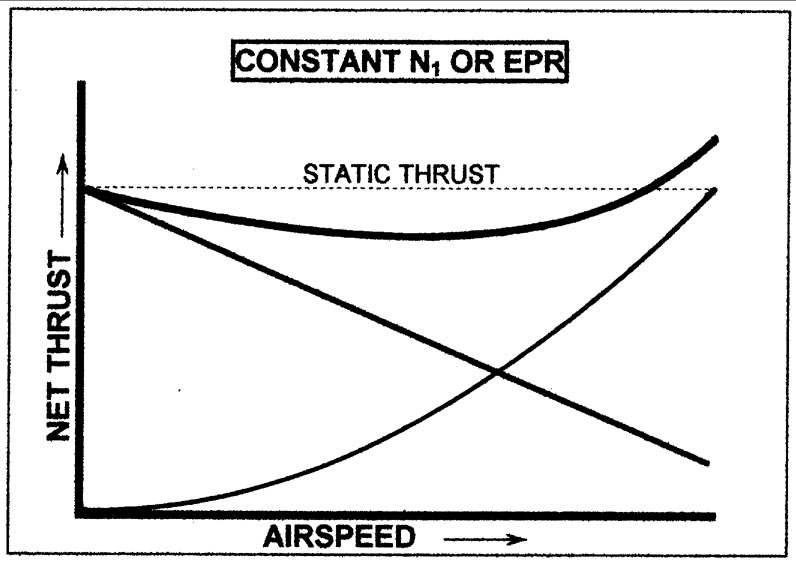Two factors are at work simultaneously, namely -
(1) Thrust decreases with forward speed, due to the thrust equation :Thrust=
W (Vo - V1)
(Where W = mass of air, Vo = Exit Velocity, and V1 = intake velocity, as
stated earlier), and
(2) Ram recovery takes place proportional to the Mach Number Squared. This
increases the intake pressure, thus unloading the work required of the
compressor (which is considerable) leaving more of the internal work
produced available for producing thrust, and, significantly, increasing Mass
Flow.
If you refer to the diagram below, static thrust (i.e. at zero speed) is
represented by the horizontal dashed line.

Speed effect (due to the thrust equation) causes actual thrust to reduce
with increasing TAS (the descending line), quite similar in concept to
thrust decline with increasing speed for the propeller aircraft. Decline is
quite uniform.
Ram Recovery (the upward curving line) exponentially causes thrust recovery
as Mach Number increases, being zero at zero speed, mediocre at medium
speeds, and significant at high speeds.
The Actual or Net Thrust is the sum of the two values, the sum of these
being shown as the upper curved line dipping below the Static Thrust line,
eventually crossing and exceeding it at high Mach Numbers. (The concept is
very similar to the addition of the Induced Drag and Form Drag values to
form the familiar "U shaped" Drag Curves).
The MINIMUM Net thrust is encountered when the Speed Effect and the Ram
Recovery effect line cross, and thrust begins to recover to static values
thereafter. For earlier generation jet aircraft (B707 etc.) minimum thrust
occurred at about M0.5, with full recovery to static values by about M0.75.
Later generation High Bypass engines do not enjoy quite the same benefits
from Ram Recovery as earlier aircraft, due to more of the Fan and less of
the Core receiving the increased dynamic pressure, but nevertheless data for
the B747 shows (at least) full recovery to static thrust at typical Climb
and Cruise Mach Numbers.
(Note that the diagram is a generic one for instructional purposes, and not
applicable to any particular engine, but the relationships are correct).
If it were not for Ram Recovery, jet aircraft would be hard pressed to make
it to much more than 300 knots.
Regards,
Old Smokey